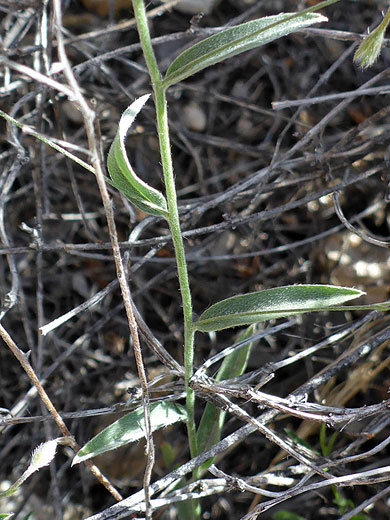Evolvulus Arizonicus, Arizona Blue-Eyes
Plants > Wildflowers > Convolvulaceae > Evolvulus Arizonicus

Purple flower with white stamens - evolvulus arizonicus, Douglas Spring Trail, Saguaro National Park, Arizona
Common names:
Arizona blue-eyes, wild dwarf morning glory
Family:
Scientific name:
Evolvulus arizonicus
Main flower color:
Range:
Arizona and south New Mexico
Height:
Up to 16 inches
Habitat:
Open slopes and plains, between 3,000 and 6,000 feet
Leaves:
Linear to narrowly lanceolate, up to one inch long; smaller towards the top of the stems
Season:
April to October
The blue or purplish flowers of evolvulus arizonicus are held on short, thread-like stalks towards the upper end of the slender stems. The corolla is nearly circular when viewed from above, crossed by five, downwards-pointing folds radiating from the middle, and five upwards-pointing folds in between. The corolla center is a narrow tube, ringed by a patch of white, and contains five white stamens and a white style. The anthers are linear, only slightly wider than the supporting filament, and around half as long. Flowers are around two thirds of an inch in diameter.
Plants typically produce a dozen or more stems from a woody base, pointing vertically upwards or partially leaning. Leaves and stems are covered by short hairs, woolly or bristly. Flowers occur singly or in groups of two or three.
Plants typically produce a dozen or more stems from a woody base, pointing vertically upwards or partially leaning. Leaves and stems are covered by short hairs, woolly or bristly. Flowers occur singly or in groups of two or three.
All Contents © Copyright The American Southwest | Comments and Questions | Contribute | Site Map


